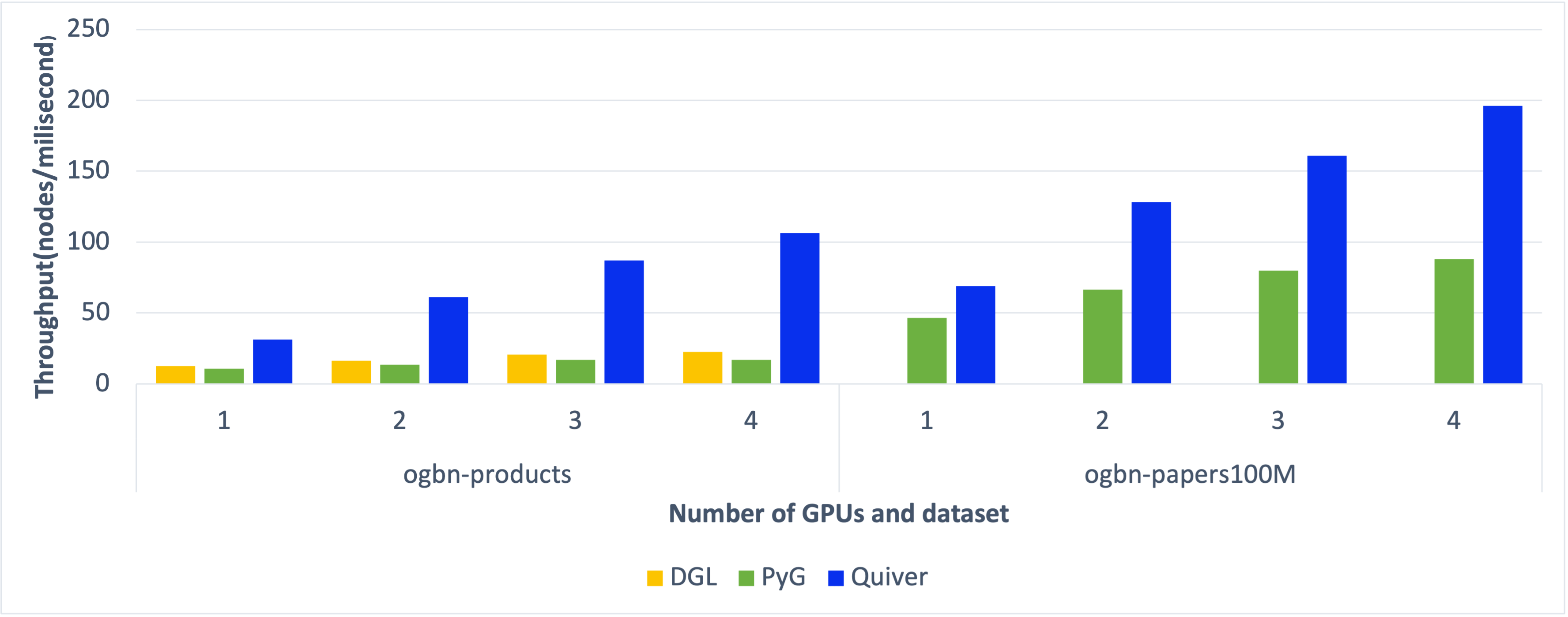Quiver is a distributed graph learning library for PyTorch Geometric (PyG). The goal of Quiver is to make distributed graph learning easy-to-use and achieve high-performance.
Why Quiver?
The primary motivation for this project is to make it easy to take a PyG program and scale it across many GPUs and CPUs. A typical scenario is: Users can use the easy-to-use APIs of PyG to efficiently develop graph learning programs, and rely on Quiver to run these PyG programs at large scale. To make such scaling effective, Quiver has several novel features:
-
High performance: Quiver enables GPUs to be effectively used in accelerating performance-critical graph learning tasks: graph sampling, feature collection and data-parallel training. Quiver thus often significantly out-perform PyG and DGL even with a single GPU (see benchmark results below), especially when processing large-scale datasets and models.
-
High scalability: Quiver can achieve (super) linear scalability in distributed graph learning. This is contributed by Quiver's novel adaptive data/feature/processor management techniques and effective usage of fast networking technologies (e.g., NVLink and RDMA).
- Easy to use: To use Quiver, developers only need to add a few lines of code in existing PyG programs. Quiver is thus easy to be adopted by PyG users and deployed in production clusters.
Below is a chart that describes a benchmark that evaluates the performance of Quiver, PyG (2.0.1) and DGL (0.7.0) on a 4-GPU server that runs the Open Graph Benchmark.
We will add multi-node result soon.
For system design details, see Quiver's design overview (Chinese version: 设计简介).
Install
Pip Install
To install Quiver:
$ pip install torch-quiverWe have tested Quiver with the following setup:
- OS: Ubuntu 18.04, Ubuntu 20.04
- CUDA: 10.2, 11.1
- GPU: P100, V100, Titan X, A6000
Test Install
You can download Quiver's examples to test installation:
$ git clone git@github.com:quiver-team/torch-quiver.git && cd torch-quiver
$ python3 examples/pyg/reddit_quiver.pyA successful run should contain the following line:
Epoch xx, Loss: xx.yy, Approx. Train: xx.yy
Install from source
To build Quiver from source:
$ git clone git@github.com:quiver-team/torch-quiver.git && cd torch-quiver
$ sh ./install.shUse Quiver with Docker
Docker is the simplest way to use Quiver. Check the guide for details.
Quick Start
To use Quiver, you need to replace PyG's graph sampler and feature collector with quiver.Sampler and quiver.Feature. The replacement usually requires only a few changes in existing PyG programs.
Use Quiver in Single-GPU PyG Scripts
Only three steps are required to enable Quiver in a single-GPU PyG script:
import quiver
...
## Step 1: Replace PyG graph sampler
# train_loader = NeighborSampler(data.edge_index, ...) # Comment out PyG sampler
train_loader = torch.utils.data.DataLoader(train_idx) # Quiver: PyTorch Dataloader
quiver_sampler = quiver.pyg.GraphSageSampler(quiver.CSRTopo(data.edge_index), sizes=[25, 10]) # Quiver: Graph sampler
...
## Step 2: Replace PyG feature collectors
# feature = data.x.to(device) # Comment out PyG feature collector
quiver_feature = quiver.Feature(rank=0, device_list=[0]).from_cpu_tensor(data.x) # Quiver: Feature collector
...
## Step 3: Train PyG models with Quiver
# for batch_size, n_id, adjs in train_loader: # Comment out PyG training loop
for seeds in train_loader: # Use PyTorch training loop in Quiver
n_id, batch_size, adjs = quiver_sampler.sample(seeds) # Use Quiver graph sampler
batch_feature = quiver_feature[n_id] # Use Quiver feature collector
...
...Use Quiver in Multi-GPU PyG Scripts
To use Quiver in multi-GPU PyG scripts, we can simply pass quiver.Feature and quiver.Sampler as arguments to the child processes launched in PyTorch's DDP training, as shown below:
import quiver
# PyG DDP function that trains GNN models
def ddp_train(rank, feature, sampler):
...
# Replace PyG graph sampler and feature collector with Quiver's alternatives
quiver_sampler = quiver.pyg.GraphSageSampler(...)
quiver_feature = quiver.Feature(...)
mp.spawn(
ddp_train,
args=(quiver_feature, quiver_sampler), # Pass Quiver components as arguments
nprocs=world_size,
join=True
)A full multi-gpu Quiver example is here.
Run Quiver
Below is an example command that runs a Quiver's script examples/pyg/reddit_quiver.py:
$ python3 examples/pyg/reddit_quiver.pyQuiver has the same launch command on both single-GPU servers and multi-GPU servers. We will provide multi-node examples soon.
Examples
We provide rich examples to show how to enable Quiver in real-world PyG scripts:
- Enabling Quiver in PyG's single-GPU examples: ogbn-product and reddit.
- Enabling Quiver in PyG's multi-GPU examples: ogbn-product and reddit.
Documentation
Quiver provides many parameters to optimise the performance of its graph samplers (e.g., GPU-local or CPU-GPU hybrid) and feature collectors (e.g., feature replication/sharding strategies). Check Documentation for details.
Community
We welcome contributors to join the development of Quiver. Quiver is currently maintained by researchers from the University of Edinburgh, Imperial College London, Tsinghua University and University of Waterloo. The development of Quiver has received the support from Alibaba and Lambda Labs.

